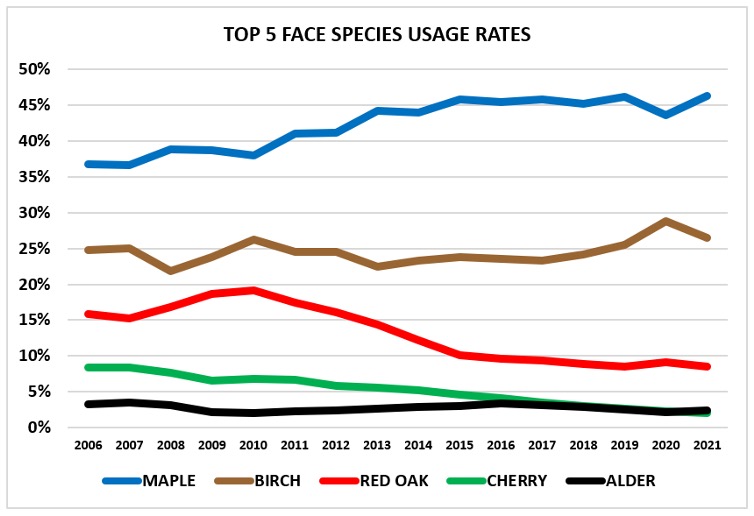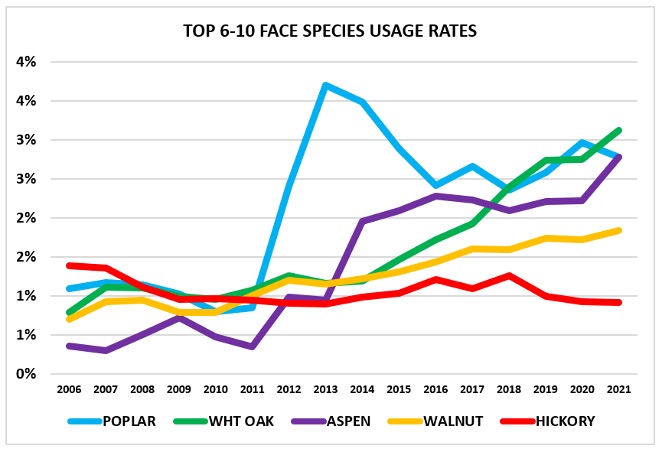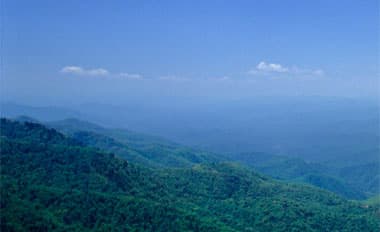Species Update
- March 2, 2022
- •
- by Columbia Forest Products
Fred Mitchell, Columbia’s Value Stream Manager for Materials, has been forecasting, buying and grading face veneers for nearly 20 years. It’s a dynamic marketplace, subject to as many or more shifting forces, trends and pressures than core materials.
You’ll be hearing from Fred now and then as he details what he sees in the face veneer sector, and sharing his insights about outlooks and ways to cope with movement in this market.
“Let’s begin by looking back and realizing that the demand for and usage of different face veneer species changes over time. This is the result of factors like fashion and design trend preferences, natural conditions like weather and growth patterns, and relative attractiveness to the timber owners and loggers for one species over another.”

“In the Top 5 Face Species we track, we can easily see the change in long-term usage rates over the last 15 years,” he said.
“While relative usage rates of Birch are flat over this period, Maple has consistently taken share from Red Oak. Cherry and Alder have also declined.”
As we move to the next 5 most popular face species, Fred notes that “all these choices have grown in relative share to the market, but at different rates.”
When Fred looks deeper into the numbers, he reminds himself that in the “up and coming” species list, growth spurts or sudden declines can often be traced back to specific customers.

“We’ve worked with companies that have outfitted restaurant chains or retail stores and really leaned on one particular species for a year or two, then moved on to other projects…that can really change the way our charts look.
“And it’s why we are reluctant to call everything a ‘trend.’ We reserve that word for things like Maple widening its lead over Red Oak. There’s no official ruling at our company or in our industry for when something goes from a pattern to a trend…
“The important thing is how producers like Columbia anticipate and respond to changes in the market, to make sure we’re ahead of the demand and availability. We thread the needle between these factors every week, and my advice for customers or project owners is always the same…if you know you’ve got a significant job coming up, the sooner we know about it, the sooner we can help line up the right supplies.
“There’s so much efficiency we can apply with the gift of time, but all that goes away when things are needed in a rush,” said Fred.
“Currently,” he added, “White Oak and Walnut are a very tight position across the market, from faces to logs. Their popularity has been growing for several years, and for the most part, suppliers have been able to keep up with the growth.
“But it seems that when these species were peaking, even more demand kept coming through. This has stretched the supply to the breaking point, and now the industry is in a real ‘catch-up’ position all the way back to the forest,” explained Fred.
Working in an industry that relies on relatively unprocessed natural raw materials like logs and veneer is what keeps Fred always on alert and ready to react. If you have any species-related questions that he can address in further articles, please email them to fmitchell@cfpwood.com




